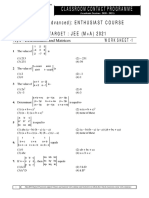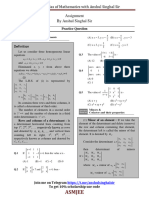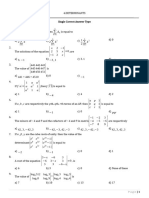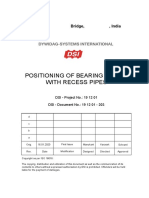Determinant PRACTICE PDF
Uploaded by
riotleaguekaranDeterminant PRACTICE PDF
Uploaded by
riotleaguekaranJEE
Lakshya JEE 2025
Maths DPP: 1
Determinants
Q1 ∣ 1 log b a ∣ Q5 ∣ a −1 0 ∣
The value of the determinant ∣ ∣ ∣ ∣
∣ log a b 1 ∣ If f (x) = ax a −1 , then
∣ ∣
is equal to: ∣ ax
2
ax a ∣
(A) 1 f (2x) − f (x) equals
(B) log a b (A) a(2a + 3x)
(C) log b a (B) ax(2x + 3a)
(D) 0 (C) ax(2a + 3x)
(D) x(2a + 3x)
Q2 ∣1 1 1 1 ∣
∣ ∣
∣1 2 3 4 ∣ Q6 ∣ a1 b1 c1 ∣
The value of the determinant ∣ ∣
∣
1 3 6 10
∣
If a2 b2 c2 = 5 , then the value of
∣ ∣ ∣ ∣
∣1 4 10 20 ∣ ∣ a3 b3 c3 ∣
is equal to ∣ b2 c3 − b3 c2 a3 c2 − a2 c3 a2 b3 − a3 b2 ∣
∣ ∣
(A) 0 (B) -1 b3 c1 − b1 c3 a1 c3 − a3 c1 a3 b1 − a1 b3 is
∣ ∣
(C) 1 (D) 2 ∣ b1 c2 − b2 c1 a2 c1 − a1 c2 a1 b2 − a2 b1 ∣
(A) 5 (B) 25
Q3 The determinant
(C) 125 (D) 0
∣ cos(α + β) − sin(α + β) cos 2β ∣
∣ ∣
D = sin α cos α sin β Q7 If the value of a third order determinant is 11 ,
∣ ∣
∣ − cos α sin α cos β ∣ then value of the square of the determinant
independent of formed by the cofactors will be
(A) α (A) 11 (B) 121
(B) β (C) 1331 (D) 14641
(C) α and β
Q8 The cofactor of the element 4 in the
(D) Neither α or β
determinant
Q4 If A + B + C = π , then value of ∣1 3 5 1∣
∣ ∣
∣ sin(A + B + C ) sin B cos C ∣
∣2 3 4 2∣
∣ ∣ is
∣ − sin B 0 tan A ∣ is ∣
8 0 1 1
∣
∣ ∣ ∣ ∣
∣ cos(A + B) − tan A 0 ∣ ∣0 2 1 1∣
(A) 0 (A) 4 (B) 10
(B) 1 (C) -10 (D) -4
(C) 2 sin B ⋅ tan A cos C
Q9
(D) 2 sin A sin B ⋅ sin C
Android App | iOS App | PW Website
JEE
∣ a b aα + b ∣
∣ ∣
If b c bα + c = 0 then
∣ ∣
∣ aα + b bα + c 0 ∣
(A) a, b, c are in A.P.
(B) a, b, c are in G.P.
(C) α is a root of ax2 + 2bx + c = 0
(D) (x − α) is a factor of ax2 + 2bx + c = 0
Q10 ∣ a b c∣ ∣ 6a 2b 2c ∣
∣ ∣ ∣ ∣
If m n p , then
= k 3m n p =
∣ ∣ ∣ ∣
∣ x y z∣ ∣ 3x y z ∣
(A) k/6 (B) 2k
(C) 3k (D) 6k
Android App | iOS App | PW Website
JEE
Lakshya JEE 2025
Maths
DPP: 2
Determinants
Q1 ∣a
1
b1 c1 ∣ The value of determinant
∣ ∣
If Δ = a2 b2 c2 , then value of ∣
−(2
5
+ 1)
2
10
2 − 1
1 ∣
∣ ∣
∣ 5
2 −1 ∣
∣a b3 c3 ∣ ∣ ∣
3 2
10 1
is
5
∣ 2a + 3b + 4c ∣ ∣2 − 1 −(2 − 1) ∣
1 1 1 b1 c1 5
2 +1
∣ ∣ ∣ ∣
2a 2 + 3b 2 + 4c 2 b2 c2 is equal to ∣ 1 1 1 ∣
∣ ∣ 5 5 2
∣ 2 −1 2 +1 −(2
10
−1) ∣
∣ 2a + 3b + 4c b3 c3 ∣
3 3 3
(A) 0 (B) 1
(A) Δ2
(C) 2 (D) 4
(B) 4Δ
(C) Δ Q5 ∣ 1 3 cos θ 1 ∣
(D) 2Δ If Δ =
∣
sin θ 1 3 cos θ
∣
, then the
1
∣ ∣ 1000
∣ 1 sin θ 1 ∣
Q2 ∣ −a2 ab ac ∣
∣ ∣ 3
If ∣ ab −b
2
bc ∣ = ka b c
2 2 2
, then k is [ maximum value of Δ - minimum value of Δ| ]
∣ ∣
∣ ac bc −c
2
∣ is equal to _____.
equal to: (A) 1 (B) -1
(A) 2 (B) 4 (C) 0 (D) 2
(C) −4 (D) 8
Q6 ∣ 52 5
3
5
4
∣
∣ ∣
Q3 ∣ 10 4 3 ∣ The value of ∣ 53 5
4
5
5
∣ , is
∣ ∣ ∣ ∣
If Δ1 = 17 7 4 , Δ2 such that ∣5
4
5
5
5
6
∣
∣ ∣
∣ 4 −5 7 ∣ (A) 5 2
∣4 x + 5 3∣ (B) 0
∣ ∣
= 7 x + 12 4 (C) 5
13
∣ ∣
∣ −5 x − 1 7∣ (D) 59
Δ1 + Δ2 = 0 , then
Q7 If every element of a third order determinant of
(A) x = 5
value of Δ is multiplied by 5, then the value of
(B) x has no real value
new determinant, is
(C) x = 0
(A) Δ (B) 5Δ
(D) x = 1
(C) 25Δ (D) 125Δ
Q4
Q8
Android App | iOS App | PW Website
JEE
If α is a non-real cube root of −2 , then the
∣ 1 2α 1 ∣
∣ ∣
value of α
2
1 3α
2
, is
∣ ∣
∣ 2 2α 1 ∣
(A) −11 (B) −12
(C) −13 (D) 0
Q9 If a ≠ b ≠ c , the value of x which satisfies the
∣ 0 x − a x − b∣
∣ ∣
equation x + a 0 x − c = 0 is
∣ ∣
∣x + b x + c 0 ∣
(A) x = 0 (B) x = a
(C) x = b (D) x = c
Q10 ∣a b c ∣ ∣y b q ∣
∣ ∣ ∣ ∣
If Δ1 = x y z and Δ2 = x a p then
∣ ∣ ∣ ∣
∣p q r∣ ∣z c r∣
Δ1 is equal to
(A) 2Δ2
(B) Δ2
(C) −Δ2
(D) None of these
Android App | iOS App | PW Website
JEE
Lakshya JEE 2025
Maths
DPP: 3
Determinants
Q1 ∣4 −4 0 ∣ (B) −1
∣ ∣
If a b + 4 c = 0 , then a + b + c is (C) abc
∣ ∣ pqr
∣a b c + 4∣ (D) 0
equal to
(A) 41 (B) 116 Q6 ∣a
2
b
2
c
2
∣
∣ ∣
If then is
2 2 2
(C) 628 (D) −4 ∣ (a + λ) (b + λ) (c + λ) ∣ k
∣ ∣
2 2 2
∣ (a − λ) (b − λ) (c − λ) ∣
Q2 ∣x 4 y + z ∣
∣ ∣ ∣ a2 2 2
∣
y 4 z + x is equal to b c
∣ ∣ ∣ ∣
= kλ a b c ,λ ≠ 0
∣z 4 x + y∣ ∣ ∣
(A) 4 (B) x + y + z ∣1 1 1 ∣
(C) xyz (D) 0 equal to:
(A) 4λabc
Q3 ∣
(a
x
+ a
−x
)
2
(a
x
− a
−x
)
2
1
∣
(B) −4λ2
∣ ∣
∣ (bx + b−x )
2
(b
x
− b
−x 2
) 1 ∣ is equal to: (C) 4λ2
∣ ∣
∣ (c
x
+ c
−x 2
) (c
x
− c
−x 2
) 1 ∣
(D) −4λabc
(A) 0
Q7 If α, β and γ are the roots of the equation
(B) 2abc
x
3
+ px + q (with p ≠ 0 and q ≠ 0 ), the value
(C) a2 b2 c2 ∣α β γ ∣
(D) abc
∣ ∣
of the determinant ∣ β γ α∣ , is
∣ ∣
Q4 If s = (a + b + c) , then value of ∣γ α β ∣
∣s + c a b ∣ (A) p (B) q
∣
c s + a b
∣
is (C) p 2
− 2q (D) None of these
∣ ∣
∣c a s + b ∣
Q8 If a, b, c are in AP , then the value of
(A) 2s 2
(B) 2s3
∣x + 2 x + 3 x + a∣
(C) s3 (D) 3s3 ∣ ∣
x + 4 x + 5 x + b is
∣ ∣
Q5 If a > 0, b > 0, c > 0 are respectively the ∣x + 6 x + 7 x + c ∣
p
th
,q
th
,r
th
terms of a G.P., then the value of (A) x − (a + b + c)
∣ log a p 1∣
(B) 9x2 + a + b + c
the determinant
∣
log b q 1
∣
is (C) a + b + c
∣ ∣
∣ log c r 1∣
(D) 0
(A) 1
Android App | iOS App | PW Website
JEE
Q9 ∣x − y − z 2x 2x ∣
∣ ∣
If Δ1 = 2y y − z − x 2y
∣ ∣
∣ 2z 2z z − x − y∣
and
Δ2
∣ x + y + 2z x y
∣
= z y + z + 2x y
∣
∣ z x z + x + 2y
∣
∣
then
∣
∣
(A) Δ1 = 2Δ2
(B) Δ2 = 2Δ1
(C) Δ1 = Δ2
(D) None of these
Q10 The value of θ satisfying the equation
2 2
∣ 1 + sin θ cos θ 4 sin 4θ ∣
∣ ∣
2 2
∣ sin θ 1 + cos θ 4 sin 4θ ∣ = 0
∣ ∣
2 2
∣ sin θ cos θ 1 + 4 sin 4θ ∣
are:
(A) 4π
24
,
3π
24
(B) 7π
24
,
5π
24
(C) 7π
24
,
11π
24
(D) 24
π
,
11π
24
Android App | iOS App | PW Website
JEE
Lakshya JEE 2025
Maths
DPP: 4
Determinants
Q1 The number of distinct real roots of The value of the determinant
∣ sin x cos x cos x ∣ ∣1 bc a(b + c) ∣
∣ ∣ ∣ ∣
cos x sin x cos x = 0 in the interval ∣1 ca b(a + c) ∣ doesn't depend on
∣ ∣
∣ ∣
∣ cos x cos x sin x ∣ ∣1 ab c(a + b) ∣
−
π
4
≤ x ≤
π
4
is (A) a (B) b
(A) 0 (B) 2 (C) c (D) a + b + c
(C) 1 (D) 3
Q6 Given that xyz = −1 , the value of the
Q2 If a, b, c are sides of the ∣x x
2
1 + x
3
∣
∣ ∣
∣1 a b ∣ determinant ∣ y y
2
1 + y
3
∣ ,
∣ ∣ ∣ ∣
△ABC , 1 c a = 0 then ∣ z z
2
1 + z
3
∣
∣ ∣
∣1 b c ∣ (A) 0 (B) positive
value of sin2 A + sin2 B + sin2 C is equal to: (C) negative (D) none of these
(A) 4
(B) 3 Q7 If a1 , a2 , … … , an. , … … are in GP and ai
2
> 0 for each i then the determinant
(C) 9
4
∣ log an log an+2 log an+4 ∣
(D) 3√ 3
∣ ∣
2 Δ = log an+6 log an+8 log an+10 is
∣ ∣
Q3 The number of positive integral solutions of the ∣ log a
n+12
log an+14 log an+16 ∣
equation equal to
∣ x3 + 1 x y
2
x z
2
∣ (A) 0 (B) 1
∣ ∣
∣ xy
2 3 2
∣ = 11 is/are (C) 2 (D) n
y + 1 y z
∣ ∣
2 2 3
∣ xz yz z + 1∣ Q8 ∣ bc ca ab ∣
(A) 0 (B) 3 The value of the determinant
∣
p q r
∣
,
∣ ∣
(C) 6 (D) 12 ∣ 1 1 1 ∣
where a, b, c are the p
th
,q
th
and r
th
terms of
Q4 ∣x + y y + z z + x∣ ∣x z y ∣
∣ ∣ ∣ ∣ a H.P., is
If y + z z + x x + y = k y x z ,
∣ ∣ ∣ ∣
(A) p + q + r (B) (a + b + c)
∣z + x x + y y + z ∣ ∣z y x∣
then k is equal to (C) 1 (D) None of these
(A) −2 (B) 2
Q9
(C) −3 (D) 3
Q5
Android App | iOS App | PW Website
JEE
If a, b, c are in AP , then the value of
∣x + 2 x + 3 x + a∣
∣ ∣
x + 4 x + 5 x + b is
∣ ∣
∣x + 6 x + 7 x + c ∣
(A) x − (a + b + c)
(B) 9x2 + a + b + c
(C) a + b + c
(D) 0
Q10 If x, y, z are integers in A.P. lying between 1 and
9 and x51, y41 and z31 are three digit
∣ 5 4 3 ∣
∣ ∣
numbers then the value of x51 y41 z31 is
∣ ∣
∣ x y z ∣
(A) x + y + z
(B) x − y + z
(C) 0
(D) None of these
Android App | iOS App | PW Website
JEE
Lakshya JEE 2025
Maths
DPP: 5
Determinants
Q1 ∣ xk x
k+2
x
k+3
∣
⎛ ⎞⎛ ⎞⎛ (C) −2n
∣ ∣
If ∣ y k
y
k+2
y
k+3
∣ = ⎜x − y⎟⎜y − z⎟⎜z (D) n2
∣ ∣
k k+2 k+3 ⎝ ⎠⎝ ⎠⎝
∣z z z ∣
Q5 ⎛ ⎞
∣ sin x cos x sin x ∣
∣ ∣
⎞ If f ⎜x⎟ = cos x − sin x cos x , find the
1 1 1 ∣ ∣
− x⎟ { + + } ⎝ ⎠
x y z ∣ x 1 1 ∣
⎠ ′
2
value of 2 f (0) ′
+ {f (1)}
, then: (A) 0 (B) 1
(A) k = −2 (B) k = −1
(C) 2 (D) 3
(C) k = 0 (D) k = 1
Q6
Q2
m
∣ 2r − 1 Cr 1 ∣
∣ ∣
If Δr = ∣ m
2
− 1 2
m
m + 1 ∣ , then
∣ ∣
2 2 2 2
∣ sin (m ) sin m sin m ∣
m
the value of ∑r=0 Δr is
(A) 1 (B) 3
(C) 2 (D) 0
Q3 The digits A, B, C are such that the three digit
numbers A88, 6B8, 86C are divisible by 72 , (A) 2(3n − r)
∣A 6 8 ∣ (B) 2(2n − 3r)
∣ ∣
then the determinant 8 B 6 is divisible (C) 3(n − 2r)
∣ ∣
∣ 8 8 C∣ (D) None of these
by
(A) 72 (B) 144 Q7 ∣a − b − c 2a 2a ∣
∣ ∣
2b b − c − a 2b is equal to
(C) 288 (D) 1216 ∣ ∣
∣ 2c 2c c − a − b∣
r
Q4 ∣1 r 2 ∣
:
∣ ∣
If Δr = ∣ 2 n n
2
∣ , then the value of (A) 0
∣ ∣
∣n
n(n+1)
2
n+1
∣
(B) a + b + c
2
∑
n
Δr is (C) (a + b + c)2
r=1
(A) n
(D) (a + b + c)3
(B) 2n
Q8
Android App | iOS App | PW Website
JEE
Let
6 5 4 3 2
ax + bx + cx + dx + ex + fx + g =
2 2
∣ (x + 1) (x + 2) (x + x) ∣
∣ ∣
∣ (x
2
+ x) x + 1 (x
2
+ 2) ∣ . Then,
∣ ∣
2 2
∣ (x + 2) (x + x) (x + 1) ∣
(A) f = 3, g = −5
(B) f = −3, g = −5
(C) f = −3, g = −9
(D) None of these
Q9 ∣1 + x 1 1 ∣
∣ ∣
1 1 + y 1 =
∣ ∣
∣ 1 1 1 + z∣
(A) xyz (1 + 1
+
1
+
1
)
x y z
(B) xyz
(C) 1 + 1
x
+
1
y
+
1
(D) x
1
+
1
y
+
1
Q10 ∣
10
C4
10
C5
11
Cm ∣
∣ ∣
The value of Δ = ∣
11
C6
11
C7
12
Cm+2 ∣ is
∣ ∣
12 12 13
∣ C8 C9 C ∣
m+4
equal to zero, where m is
(A) 6
(B) 4
(C) 5
(D) None of these
Android App | iOS App | PW Website
JEE
Lakshya JEE 2025
Maths
DPP: 6
Determinants
Q1 If ω(≠ 1) is a cube root of unity, then value of ∣ sin2 (x +
3π
2
) sin
2
(x +
5π
2
) sin
2
(x +
7π
2
)
∣
the determinant ∣ sin (x +
3π
) sin (x +
5π
) sin (x +
7π
)
2 2 2
2 2
∣ 1 (1 + i + ω ) ω ∣ ∣
3π 5π 7π
∣ ∣
∣ sin (x − ) sin (x − ) sin (x − )
∣1 − i −1 ω
2
− 1∣ is 2 2 2
∣ ∣ ∣
∣ −i −i + ω − 1 −1 ∣
∣
(A) 0 ∣
∣
(B) 1
∣
(C) i (A) 1 (B) 2
(D) ω (C) 3 (D) 0
Q2 Which of the following values of α satisfy the Q6
equation
2 2 2
∣ (1 + α) (1 + 2α) (1 + 3α) ∣
∣ ∣
∣ (2 + α)
2
(2 + 2α)
2
(2 + 3α)
2
∣ = ?
∣ ∣
2 2 2
∣ (3 + α) (3 + 2α) (3 + 3α) ∣
−648α
(A) −4 (B) 9
(C) −9 (D) 4
Q3 ∣ a1 α1 + b1 β 1 a1 α2 + b1 β 2 a1 α3 + b1 β 3 ∣
∣ ∣
a2 α1 + b2 β 1 a2 α2 + b2 β 2 a2 α3 + b2 β 3
∣ ∣
∣ a3 α1 + b3 β 1 a3 α2 + b3 β 2 a3 α3 + b3 β 3 ∣
=
(A) Δ32
(A) 0 (B) 1 (B) Δ22
(C) −1 (D) 2 (C) Δ42
(D) None of these
Q4 Find the coefficient of x in the determinant
∣
(1 + x)
a 1 b1
(1 + x)
a 1 b2
(1 + x)
a 1 b3
∣ Q7 The value of
∣ ∣
a 2 b1 a 2 b2 a 2 b3 ∣ cos(x − a) cos(x + a) cos x ∣
∣ (1 + x) (1 + x) (1 + x) ∣
∣ ∣
∣
a 3 b1 a 3 b2 a 3 b3
∣ ∣ sin(x + a) sin(x − a) sin x ∣ is equal
∣ (1 + x) (1 + x) (1 + x) ∣ ∣ ∣
∣ cos a tan x cos a cot x cosec 2x ∣
(A) 0 (B) 1
(A) 1
(C) −1 (D) 2
(B) sin a cos a
Q5 The value of the determinant (C) 0
Android App | iOS App | PW Website
JEE
(D) sin x cos x
Q8
3 3 2
∣2 3 3.2 + 3.2 + 1 ∣
∣ ∣
∣3
3
4
3
3.3
2
+ 3.3 + 1 ∣ is equal to
∣ ∣
3 3 2
∣4 5 3.4 + 3.4 + 1 ∣
(A) 0 (B) 1
(C) 92 (D) None of these
Q9 If ω, ω 2 are imaginary cube roots of unity and
∣1 1 1 ∣ ∣ 1 1 ω ∣
∣ ∣ ∣ ∣
Δ1 =
∣
1 ω ω
2
∣
and Δ2 =
∣
1 1 ω
2
∣
,
2 2
∣1 ω ω ∣ ∣ω ω 1 ∣
Δ1
then Δ2
is equal to
–
(A) √3
–
(B) √3 i
(C) 1
(D) -1
Q10 If a, b and c are the roots of the equation
x
3
− 6x
2
+ 11x − 6 = 0 and
Δ ,
3 3 3
∣ 3 a + b + c a + b + c
∣
2 2 2 4 4 4
= ∣ a + b + c a + b + c a + b + c
∣
2 2 2 3 3 3 5 5 5
∣a + b + c a + b + c a + b + c
∣
∣
∣
∣
∣
then Δ is equal to
(A) -24 (B) 24
(C) 12 (D) -12
Android App | iOS App | PW Website
JEE
Lakshya JEE 2025
Maths
DPP: 7
Determinants
Q1 If the system of equations (C) HP (D) AGP
x − 2y + 5z = 3, 2x − y +z = 1 and
Q5 If the lines ax + y + 1 = 0, x + by + 1 = 0
11x − 7y + pz = q , has infinitely many
and x + y + c = 0(a, b, c being distinct and
solutions, then
different from 1) are concurrent, then the value
(A) p + q = 2
of 1
+
1
+
1
is
(B) p + q = 10 1−a 1−b 1−c
(C) p − q = 2
(A) 0 (B) 1
(D) p − q = 5
(C) -1 (D) 2
Q2 Let a, x, y, z be real numbers satisfying Q6 If c < 1 and the system of equations
the equations x + y − 1 = 0 , 2x − y − c = 0 and
ax + ay = z, x + ay = z, x + ay = az , where −bx + 3by − c = 0 is consistent, then the
x, y, z are not all zero, then the number of the possible real values of b are
possible values of a is (A) b ∈ (−3
3
4
)
(A) 0 (B) 1 (B) b ∈ (
−3
, 4)
2
(C) 2 (D) 3 (C) b ∈ (
−3
, 3)
4
Q3 If a + b + c = 0 and (D) b ∈ (
−3
,
3
)
2 4
a
2
+ b
2
+ c
2
,
− ab − bc − ca ≠ 0 ∀a, b, c ∈ R ,
then the system of equations ax + by+ Q7 If the system of equations
cz = 0, bx + cy + az = 0 and x − ky − z = 0, kx − y−
cx + ay + bz = 0 has z = 0, x + y − z = 0 has a non-zero solution,
(A) A unique solution then the possible values of k are
(B) Infinite solutions (A) −1, 2 (B) 1, 2
(C) No solution (C) 0, 1 (D) −1, 1
(D) Exactly two solution
Q8 Given 2x − y + 2z = 2, x − 2y − z = −4 ,
Q4 If the system of equations x + y + λz = 4 then the value of λ such that
x + 4ay + az = 0 the given system of equation has no solution is:
x + 3by + bz = 0 (A) −3 (B) 1
x + 2cy + cz = 0 (C) 0 (D) 3
have a non-zero solution, then a, b, c(≠ 0) are
Q9 If the trivial solution is the only solution of the
in
system of equations
(A) AP (B) GP
Android App | iOS App | PW Website
JEE
x − k y + z = 0
k x +3 y −k z =0
3x + y – z = 0
Then, the set of all values of ′ k′ is:
(A) {2, −3}
(B) R − {2, −3}
(C) R − {2}
(D) R − {−3}
Q10 The system of equation,
λx + y + z = 0,
−x + λy + z = 0,
−x − y + λz = 0
will have a non-zero solution if real values of λ
are given by:
(A) 5 (B) −1
(C) 1 (D) 0
Android App | iOS App | PW Website
JEE
Lakshya JEE 2025
Maths
DPP: 8
Determinants
Q1 Let a, b and c any real numbers. Suppose that Q5 The system of linear equations
there are real numbers x, y and z not all zero x + y + z = 2
such that x = cy + bz, y = az + cx and 2x + y − z = 3
z = bx + ay , then a
2
+ b
2
+ c
2
+ 2abc is 3x + 2y + kz = 4
equal to has a unique solution, is
(A) 1 (B) 2 (A) k ≠ 0
(C) −1 (D) 0 (B) −1 < k < 1
(C) −2 < k < 2
Q2 The system of equations (D) k = 0
ax + 4y + z = 0, bx + 3y
+z = 0, cx + 2y + z = 0 has non-trivial Q6 The system of equations
solution if a, b, c are in x + y + z = 5
(A) AP x + 2y + 3z = 9
(B) GP x + 3y + λz = μ
(C) HP
(D) None of these has a unique solution, if
(A) λ = 5, μ = 13
Q3 If 0 ≤ θ ≤ π and the system of equations (B) λ ≠ 5
x = (sinθ)y + (cosθ)z
(C) λ = 5, μ ≠ 13
y = z + (cosθ)x (D) λ ≠ 13
z = (sinθ)x + y
Q7 If 3α is a factor of the determinant
has a non-trivial solution, then is equal to
8θ
π ∣ 1 1 1 ∣
(A) 2 (B) 4 ∣ n n+3 n+6
∣
,
C1 C1 C1
∣ ∣
(C) 6 (D) 8 n n+3 n+6
∣ C2 C2 C2 ∣
Q4 The system of equations
ax − y − z = a − 1, x − ay
find the maximum value of α.
−z = a − 1, x − y − az = a − 1 has no
solution, if a is Q8 Consider a system of equations
(A) either −2 or 1 2x + ay + 6z = 8 ,
(B) −2 x + 2y + bz = 5, x + y + 3z = 4 then :
(C) 1 The system of equations will have infinite
(D) not −2 solution if
Android App | iOS App | PW Website
JEE
(A) b = 4 (B) b = 2
(C) a = 3 (D) a = 2
Q9 Consider a system of equations
2x + ay + 6z = 8 ,
x + 2y + bz = 5, x + y + 3z = 4 then :
The system of equations will have no solution if
(A) a = 2, b ≠ 3
(B) a ≠ 2, b ≠ 3
(C) a ≠ 2, b = 3
(D) a = 2, b = 3
Q10 Consider a system of equations
2x + ay + 6z = 8 ,
x + 2y + bz = 5, x + y + 3z = 4 then : The
given system of equations will have unique
solution if
(A) a ≠ 2, b ≠ 3
(B) a ≠ 2
(C) a = 2, b = 3
(D) a = 2, b ≠ 3
Android App | iOS App | PW Website
JEE
Lakshya JEE 2025
Mathematics
Determinants Practice Sheet
Q1 Let m be a positive integer & Q5 If α, β&γ are the roots of the equation
x
3
+ px + q = 0 ,
m
∣ 2r − 1 Cr 1 ∣
∣ ∣ then the value of the determinant
2 m
Dr = ∣ m − 1 2 m + 1 ∣
∣α β γ ∣
∣ ∣
2 2 2 2 ∣ ∣
∣ sin ( m ) sin ( m) sin ( m + 1) ∣
β γ α =
∣ ∣
(0 ≤ r ≤ m), ∣γ α β ∣
m
(A) p
then the value of ∑r=0 Dr is given by:
(B) q
(A) 0
(C) p2 − 2q
(B) m 2
− 1
(D) none
(C) 2m
(D) 2m sin2 (2m ) Q6 If the system of equations
Q2 There are two values of x making the value of x + 2y + 2z = 1
∣1 −2 5 ∣
x − y + 3z = 3
∣ ∣
the determinant 2 x −1 equal to 86 . x + 11y − z = b
∣ ∣
∣0 4 2x ∣
The sum of these two numbers, is has solutions, then the value of b lies in the
(A) -4 (B) 5 interval-
(C) -3 (D) 9 (A) (−7, −4) (B) (−4, 0)
(C) (0, 3) (D) (3, 6)
Q3 Let f (x) ,
∣ 1 + sin2 x 2
∣
Q7 The system of equations
cos x 4 sin 2x
∣ ∣
2 2
= ∣ sin x 1 + cos x 4 sin 2x ∣
kx + (k + 1)y + (k − 1)z = 0
∣ ∣
2 2
∣ sin x cos x 1 + 4 sin 2x ∣ (k + 1)x + ky + (k + 2)z = 0
then (k − 1)x + (k + 2)y + kz = 0
the maximum value of f (x) =
(A) 2 (B) 4 has a non-trivial solution for-
(C) 6 (D) 8 (A) exactly three real values of k .
(B) exactly two real values of k .
Q4 If px4 + qx
3
+ rx
2
+ sx + t
(C) exactly one real value of k .
2
∣x + 3x x − 1 x + 3∣ (D) infinite number of values of k .
∣ ∣
= x + 1 2 − x x − 3
∣ ∣
Q8 If A, B and C are such that A + B + C = 0 ,
∣ x − 3 x + 4 3x ∣
∣ 1 cos C cos B ∣
then t =
∣ ∣
then the value of cos C 1 cos A is
(A) 33 (B) 0 ∣ ∣
∣ cos B ∣
(C) 21 (D) none cos A 1
(A) 1
Android App | iOS App | PW Website
JEE
(B) 1 − cos2 A − cos
2
B − cos
2
C − 2 cos and
A cos B cos C
(C) 0 ∣ 3 1 + S1 1 + S2 ∣
∣ ∣
(D) -1 Δ =
∣
1 + S1 1 + S2 1 + S3
∣
∣ 1 + S2 1 + S3 1 + S4 ∣
Q9 The determinant
∣ xp + y x y ∣ If Δ < 0 , then the equation ax2 + bx + c = 0
∣ ∣
yp + z y z = 0 if: has
∣ ∣
∣ 0 xp + y yp + z ∣ (A) positive real roots
(A) x, y, z are in A.P. (B) negative real roots
(B) x, y, z are in G.P. (C) equal roots
(C) x, y, z are in H.P. (D) imaginary roots
(D) xy, yz, zx are in A.P.
Q14 Let A and B be two invertible matrices of order
Q10 Area of triangle whose vertices 3×3. If det (ABAT) = 8 and det (AB–1) = 8, then det
2
(a, a ) (b, b ) (c, c )
2 2
(BA–1 BT) is equal to:
is 1
2
, and area of another triangle whose (A) 1
4
(B) 1
vertices are 2
(p, p ) , (q, q )
2
and (r, r )
2
is 4 , (C) 1
16
(D) 16
then the value of
∣ (1 + ap)
2
(1 + bp)
2
(1 + cp)
2
∣
Q15 If
∣ ∣ ∣x + 1 x x ∣
∣ (1 + aq)
2
(1 + bq)
2
(1 + cq)
2
,
∣
∣ ∣ 9
⎛ ⎞
∣ ∣ x x + λ x = ⎜103x + 81⎟,
2 2 2 ∣ ∣ 8
∣ (1 + ar) (1 + br) (1 + cr) ∣ ⎝ ⎠
2
∣ x x x + λ ∣
(A) 2 (B) 4
then λ, are the roots of the equation
λ
(C) 8 (D) 16 3
(A) 4x 2
+ 24x − 27 (B) 4x2 − 24x + 27
Q11 If the system of equations = 0 = 0
(C) 4x2 + 24x + 27 (D) 4x2 − 24x − 27
x − λy − z = 0 ⎫ = 0 = 0
⎪
λx − y − z = 0 ⎬
⎭
⎪
Q16 If a1 , a2 , a3 , 5, 4, a6 , a7 , a8 , a9 are in H . P. and
x + y − z = 0 ∣a
1 a2 a3 ∣
∣ ∣
D = 5 4 a6 , then the value of [D] is
has a unique solution, then the range of λ is ∣ ∣
∣a a9 ∣
. Then the value of (a2 is: a8
2
R − {a, b} + b ) 7
(where
(A) 1 (B) 2
[ ⋅ ] represents the greatest integer function)
(C) 4 (D) 9
Q17 ∣a b a + b∣
Q12 ∣ −1 2 1∣
∣ ∣
∣ – – ∣ Let D1 = c d c + d and
The value of 3 + 2√2 2 + 2√2 1 is equal ∣ ∣
∣ ∣
– – ∣a b a − b∣
∣ 3 − 2√2 2 − 2√2 1∣
∣a c a + c ∣
to ∣ ∣
D2 = b d b + d then the value of
(A) zero ∣ ∣
– ∣a c a + b + c∣
(B) −16√2 D1
– ∣ ∣ , where b ≠ 0 and ad ≠ bc , is.........
(C) −8√2 ∣ D2 ∣
(D) None of these
Q13 Let α, β be the roots of the equation
ax
2
+ bx + c = 0 . Let Sn = α
n
+ β
n
for n ≥ 1
Android App | iOS App | PW Website
JEE
Q18 ∣ 1 3 cos θ 1 ∣ Q23 Assertion (A): If every element of a third order
∣ ∣
If Δ = sin θ 1 3 cos θ , then the determinant of value D is multiplied by 5 , then
∣ ∣
∣ 1 sin θ 1 ∣ the value of the new determinant is 125D.
value of Reason (R): If k is a scalar and A is an n × n
(Δmax ) /2 is.............. matrix, then |kA| = k
n
|A|
(A) Both A and R are true and R is the correct
Q19 ∣ xn x
n+2
x
n+4
∣
∣ ∣ explanation of A
If ∣y
n
y
n+2
y
n+4
∣ =
∣ ∣ (B) Both A and R are true but R is not the
n n+2 n+4
∣ z z z ∣
correct explanation of A
then is
1 1 1 1 1 1
( − )( − )( − ) −n
y
2
x
2
z
2
y
2
x
2
z
2
(C) A is true but R is false
........... (D) A is false and R is true
Q20 If the system of linear equations Q24 The system of equation
(cos θ)x + (sin θ)y + cos θ = 0
x + 3y + 2z = 6
(sin θ)x + (cos θ)y + sin θ = 0
x + ay + 2z = 7
(cos θ)x + (sin θ)y − cos θ = 0
x + 3y + 2z = b
is consistent, then find the number of possible
value of θ is .(where θ ∈ [0, 2π] ) has
(A) unique solution, if a = 2 and b ≠ 6 .
Q21 Assertion (A): If the matrix
1 3 λ + 2
(B) infinitely many solution, if a = 4 and b .
= 6
⎡ ⎤
A = ⎢2 is singular, then λ = 4 . (C) no solution, if a = 5 and b = 7 .
4 8 ⎥
⎣ ⎦ (D) no solution, if a = 3 and b = 5 .
3 5 10
Reason (R): If A is a singular matrix, then Q25 Which of the following determinant(s)
|A| = 0 . vanish(es)?
(A) Both A and R are true and R is the correct (A) ∣ 1 bc bc(b + c) ∣
explanation of A ∣
∣1 ca
∣
ca(c + a) ∣
(B) Both A and R are true but R is not the ∣ ∣
∣1 ab ab(a + b) ∣
correct explanation of A (B) ∣ 1 ab
1
+
1
∣
a
(C) A is true but R is false
b
∣ ∣
1 1
∣1 bc + ∣
(D) A is false and R is true ∣
b c
∣
1 1
∣1 ca + ∣
c a
Q22 Let α, β be the roots of the equation (C) ∣ 0 a − b a − c∣
ax
2
+ bx + c = 0 . ∣
b − a 0 b − c
∣
∣ ∣
Let Sn = α
n
+ β
n
for n ≥ 1 and ∣c − a c − b 0 ∣
(D) ∣ logx xyz log x y log x z ∣
∣ 3 1 + S1 1 + S2 ∣ ∣ ∣
∣ ∣ ∣ log y xyz 1 log y z ∣
Δ = 1 + S1 1 + S2 1 + S3
∣ ∣ ∣ ∣
∣ log xyz log z y 1 ∣
∣1 + S 1 + S3 1 + S4 ∣ z
2
If a, b, c are rational and one of the roots of the Q26 A and B are square matrices such that det.
equations is 1 + √2 , then the value of Δ is
– (A) = 1, BB
T
= I , det. (B) > 0 , and
(A) 8 (B) 12 A(adj. A + adj. B) = B AB . −1
=
(C) 30 (D) 32 (A) B −1
A
(B) AB −1
(C) AT B−1
Android App | iOS App | PW Website
JEE
(D) BT A−1
Q27 Let α, β be the roots of the equation
ax
2
+ bx + c = 0 . Let Sn = α
n
+ β
n
for n ≥ 1
and
∣ 3 1 + S1 1 + S2 ∣
∣ ∣
Δ = 1 + S1 1 + S2 1 + S3
∣ ∣
∣ 1 + S2 1 + S3 1 + S4 ∣
If Δ > 0 , then
(A) f (1) > 0
(B) f (1) < 0
(C) f (1) = 0
(D) cannot say anything about f (1)
Q28 If
∣x 3 6 ∣ ∣2 x 7 ∣ ∣4 5 x∣
∣ ∣ ∣ ∣ ∣ ∣
3 6 x = x 7 2 = 5 x 4 ,
= 0
∣ ∣ ∣ ∣ ∣ ∣
∣6 x 3 ∣ ∣7 2 x∣ ∣x 4 5 ∣
then x is equal to
(A) 0 (B) −9
(C) 3 (D) none of these
Q29 If a, b, c are positive and are the p th, q th, and
r th terms, respectively, of a G.P., then
∣ log a p 1∣
∣ ∣
Δ = log b q 1 is
∣ ∣
∣ log c r 1∣
(A) 0
(B) log(abc)
(C) −(p + q + r)
(D) none of these
Q30 ∣ a b − c c + b∣
∣ ∣
If a + c b c − a = 0 , then the line
∣ ∣
∣a − b a + b c ∣
ax + by + c = 0 passes through the fixed point
which is
(A) (1, 2) (B) (1, 1)
(C) (−2, 1) (D) (1, 0)
Android App | iOS App | PW Website
JEE
Answer Key
Q1 (A) Q16 2
Q2 (A) Q17 2
Q3 (C) Q18 5
Q4 (C) Q19 4
Q5 (D) Q20 2
Q6 (A) Q21 (A)
Q7 (C) Q22 (D)
Q8 (C) Q23 (A)
Q9 (B) Q24 (B, C, D)
Q10 (D) Q25 (A, B, C, D)
Q11 (B) Q26 (A)
Q12 (B) Q27 (D)
Q13 (D) Q28 (B)
Q14 (C) Q29 (A)
Q15 (B) Q30 (B)
Android App | iOS App | PW Website
You might also like
- 680f2f3c8a6ba11c80ce08b2 - ## - Determinants QuestionNo ratings yet680f2f3c8a6ba11c80ce08b2 - ## - Determinants Question174 pages
- Advance Level DPP Matrices and Determinants SolutionsNo ratings yetAdvance Level DPP Matrices and Determinants Solutions20 pages
- Determinant - DPP 02 (Of Lec 04) - Lakshya JEE 2024No ratings yetDeterminant - DPP 02 (Of Lec 04) - Lakshya JEE 20242 pages
- 680f2f3c8a6ba11c80ce08b2 - ## - Determinants QuestionNo ratings yet680f2f3c8a6ba11c80ce08b2 - ## - Determinants Question29 pages
- Class 12 Mathematics Competency Based Question Bank 4 Determinants Questions100% (1)Class 12 Mathematics Competency Based Question Bank 4 Determinants Questions81 pages
- Ncert Exemplar Math Class 12 Chapter 04 DeterminantsNo ratings yetNcert Exemplar Math Class 12 Chapter 04 Determinants38 pages
- Ncert Exemplar Math Class 12 Chapter 04 DeterminantsNo ratings yetNcert Exemplar Math Class 12 Chapter 04 Determinants38 pages
- NCERT Solutions Class 12 Math Chapter 4 DeterminantsNo ratings yetNCERT Solutions Class 12 Math Chapter 4 Determinants42 pages
- Lakshya JEE 2025: Mathematics DeterminantsNo ratings yetLakshya JEE 2025: Mathematics Determinants5 pages
- Determinants and Linear Equations PracticeNo ratings yetDeterminants and Linear Equations Practice14 pages
- DPT - Determinants - 02 (26072023) - 21910116 - 2024 - 06 - 24 - 19 - 50No ratings yetDPT - Determinants - 02 (26072023) - 21910116 - 2024 - 06 - 24 - 19 - 502 pages
- Class 12th Maths Chapter 4 (Determinants) UnsolvedNo ratings yetClass 12th Maths Chapter 4 (Determinants) Unsolved10 pages
- Determinants Practice Booklet 1694272500114No ratings yetDeterminants Practice Booklet 16942725001145 pages
- Matrices and Determinants - DPP 15.3 - Shaurya 2.0No ratings yetMatrices and Determinants - DPP 15.3 - Shaurya 2.07 pages
- Solution - Matrices Determinants Sheet - MathonGo BITSAT Crash CourseNo ratings yetSolution - Matrices Determinants Sheet - MathonGo BITSAT Crash Course9 pages
- Chapter Test-12 (Matrices and Determinants) SOLUTIONSNo ratings yetChapter Test-12 (Matrices and Determinants) SOLUTIONS3 pages
- DPP - Class7 - Maths - Simple Equations - SolutionsNo ratings yetDPP - Class7 - Maths - Simple Equations - Solutions13 pages
- En 0104 Serge Lang Basic Mathematics Answers100% (2)En 0104 Serge Lang Basic Mathematics Answers3 pages
- HK - F3 Math 08-09 Final Exam Paper I - QN & Ans100% (1)HK - F3 Math 08-09 Final Exam Paper I - QN & Ans12 pages
- Harmonic Motion of A Maxwell Model: Trigonometric NotationNo ratings yetHarmonic Motion of A Maxwell Model: Trigonometric Notation4 pages
- Maths Class X Sample Paper Test 15 For Board Exam 2024No ratings yetMaths Class X Sample Paper Test 15 For Board Exam 20246 pages
- Camba, Kristine Joy b.,Beed4-Educ30014 AssignmentNo ratings yetCamba, Kristine Joy b.,Beed4-Educ30014 Assignment3 pages
- Set 1 Practice Booklet 1 Higher (Non-Calculator)No ratings yetSet 1 Practice Booklet 1 Higher (Non-Calculator)21 pages
- Final JEE 2023 STRAIGHT LINES MAIN+ADVANCED ONE SHOT SERIESNo ratings yetFinal JEE 2023 STRAIGHT LINES MAIN+ADVANCED ONE SHOT SERIES81 pages
- 191201-203 - Positioning of Bearing Plates With Recess PipesNo ratings yet191201-203 - Positioning of Bearing Plates With Recess Pipes4 pages





















































































